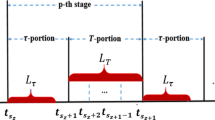Abstract
In this paper, an optimal feedback, for a free vibrating semi-active controlled plant, is derived. The problem is represented as a constrained optimal control problem of a single input, free vibrating bilinear system, and a quadratic performance index. It is solved by using Krotov’s method and to this end, a novel sequence of Krotov functions that suits the addressed problem, is derived. The solution is arranged as an algorithm, which requires solving the states equation and a differential Lyapunov equation in each iteration. An outline of the proof for the algorithm convergence is provided. Emphasis is given on semi-active control design for stable free vibrating plants with a single control input. It is shown that a control force, derived by the proposed technique, obeys the physical constraint related with semi-active actuator force without the need of any arbitrary signal clipping. The control efficiency is demonstrated with a numerical example.






Similar content being viewed by others
Notes
Recall that \({\mathbf {M}}>0\), \({\mathbf {K}}>0\) iff \({\mathbf {z}}^T{\mathbf {M}}{\mathbf {z}}>0\), \({\mathbf {z}}^T{\mathbf {K}}{\mathbf {z}}>0\) for all \({\mathbf {z}}\in \mathbb {R}^{n_z}\), \({\mathbf {z}}\ne {\mathbf {0}}\) and \({\mathbf {C}}_d\ge 0\) iff \({\mathbf {z}}^T{\mathbf {C}}_d{\mathbf {z}}\ge 0\) for all \({\mathbf {z}}\in \mathbb {R}^{n_z}\).
References
Wang, H.: Feedback stabilization of bilinear control systems. SIAM J. Control Optim. 36(5), 1669–1684 (1998). doi:10.1137/S0363012996305498
Krotov, V.F., Bulatov, A.V., Baturina, O.V.: Optimization of linear systems with controllable coefficients. Automat. Remote Control 72(6), 1199–1212 (2011). doi:10.1134/S0005117911060063
Bruni, C., DiPillo, G., Koch, G.: Bilinear systems: an appealing class of “nearly linear” systems in theory and applications. IEEE Trans. Autom. Control 19(4), 334–348 (1974)
Aganovic, Z., Gajic, Z.: The successive approximation procedure for finite-time optimal control of bilinear systems. IEEE Trans. Autom. Control 39(9), 1932–1935 (1994). doi:10.1109/9.317128
Chanane, B.: Bilinear quadratic optimal control: a recursive approach. Optim. Control Appl. Methods 18, 273–282 (1997)
Lee, S.H., Lee, K.: Bilinear systems controller design with approximation techniques. J. Chungcheong Math. Soc. 18(1), 101–116 (2005)
Costanza, V.: Finding initial costates in finite-horizon nonlinear-quadratic optimal control problems. Optim. Control Appl. Methods 29(3), 225–242 (2008)
Ribakov, Y., Gluck, J., Reinhorn, A.M.: Active viscous damping system for control of MDOF structures. Earthq. Eng. Struct. Dyn. 30(2), 195–212 (2001). doi:10.1002/1096-9845(200102)30:2<195::AID-EQE4>3.0.CO;2-X
Morales-Beltran, M., Paul, J.: Technical note: active and semi-active strategies to control building structures under large earthquake motion. J. Earthq. Eng. 19(7), 1086–1111 (2015). doi:10.1080/13632469.2015.1036326
Scruggs, J.T.: Structural control using regenerative force actuation networks. Ph.D. thesis, California Institute of Technology (2004)
Patten, W.N., Kuo, C.C., He, Q., Liu, L., Sack, R.L.: Seismic structural control via hydraulic semi-active vibration dampers (savd). In: Proceedings of the 1st world conference on structural control (1994)
Dyke, S.J., Spencer Jr., B.F., Sain, M.K., Carlson, J.D.: Modeling and control of magnetorheological dampers for seismic response reduction. Smart Mater. Struct. 5(5), 565 (1996)
Sadek, F., Mohraz, B.: Semiactive control algorithms for structures with variable dampers. J. Eng. Mech. 124(9), 981–990 (1998)
Yuen, K.V., Shi, Y., Beck, J.L., Lam, H.F.: Structural protection using MR dampers with clipped robust reliability-based control. Struct. Multidiscip. Optim. 34(5), 431–443 (2007). doi:10.1007/s00158-007-0097-3
Aguirre, N., Ikhouane, F., Rodellar, J.: Proportional-plus-integral semiactive control using magnetorheological dampers. J. Sound Vib. 330(10), 2185–2200 (2011)
Robinson, W.D.: A pneumatic semi-active control methodology for vibration control of air spring based suspension systems. Ph.D. thesis, Iowa State University (2012)
Ribakov, Y.: Semi-active pneumatic devices for control of MDOF structures. Open Constr. Build Technol. J. 3, 141–145 (2009)
Agrawal, A., Yang, J.: A Semi-active Electromagnetic Friction Damper for Response Control of Structures, Chap. 5. American Society of Civil Engineers, Reston (2000). doi:10.1061/40492(2000)6
Halperin, I., Agranovich, G.: Optimal control with bilinear inequality constraints. Funct. Differ. Equ. 21(3–4), 119–136 (2014)
Wang, D.H., Liao, W.H.: Magnetorheological fluid dampers: a review of parametric modelling. Smart Mater. Struct. 20(2), 023001 (2011)
Halperin, I., Ribakov, Y., Agranovich, G.: Optimal viscous dampers gains for structures subjected to earthquakes. Struct. Control Health Monit. 23(3), 458–469 (2016). doi:10.1002/stc.1779
Seierstad, A., Sydsaeter, K.: Sufficient conditions in optimal control theory. Int. Econ. Rev. 18(2), 367–391 (1977)
Krotov, V.F.: A technique of global bounds in optimal control theory. Control Cybern. 17(2–3), 115–144 (1988)
Krotov, V.F.: Global Methods in Optimal Control Theory. Chapman & Hall/CRC Pure and Applied Mathematics. CRC Press (1995)
Khurshudyan, A.Z.: The Bubnov–Galerkin method in control problems for bilinear systems. Autom. Remote Control 76(8), 1361–1368 (2015). doi:10.1134/S0005117915080032
Acknowledgements
Ido Halperin is grateful for the support of The Irving and Cherna Moskowitz Foundation for his scholarship.
Author information
Authors and Affiliations
Corresponding author
Rights and permissions
About this article
Cite this article
Halperin, I., Agranovich, G. & Ribakov, Y. Optimal Control of a Constrained Bilinear Dynamic System. J Optim Theory Appl 174, 803–817 (2017). https://doi.org/10.1007/s10957-017-1095-2
Received:
Accepted:
Published:
Issue Date:
DOI: https://doi.org/10.1007/s10957-017-1095-2




